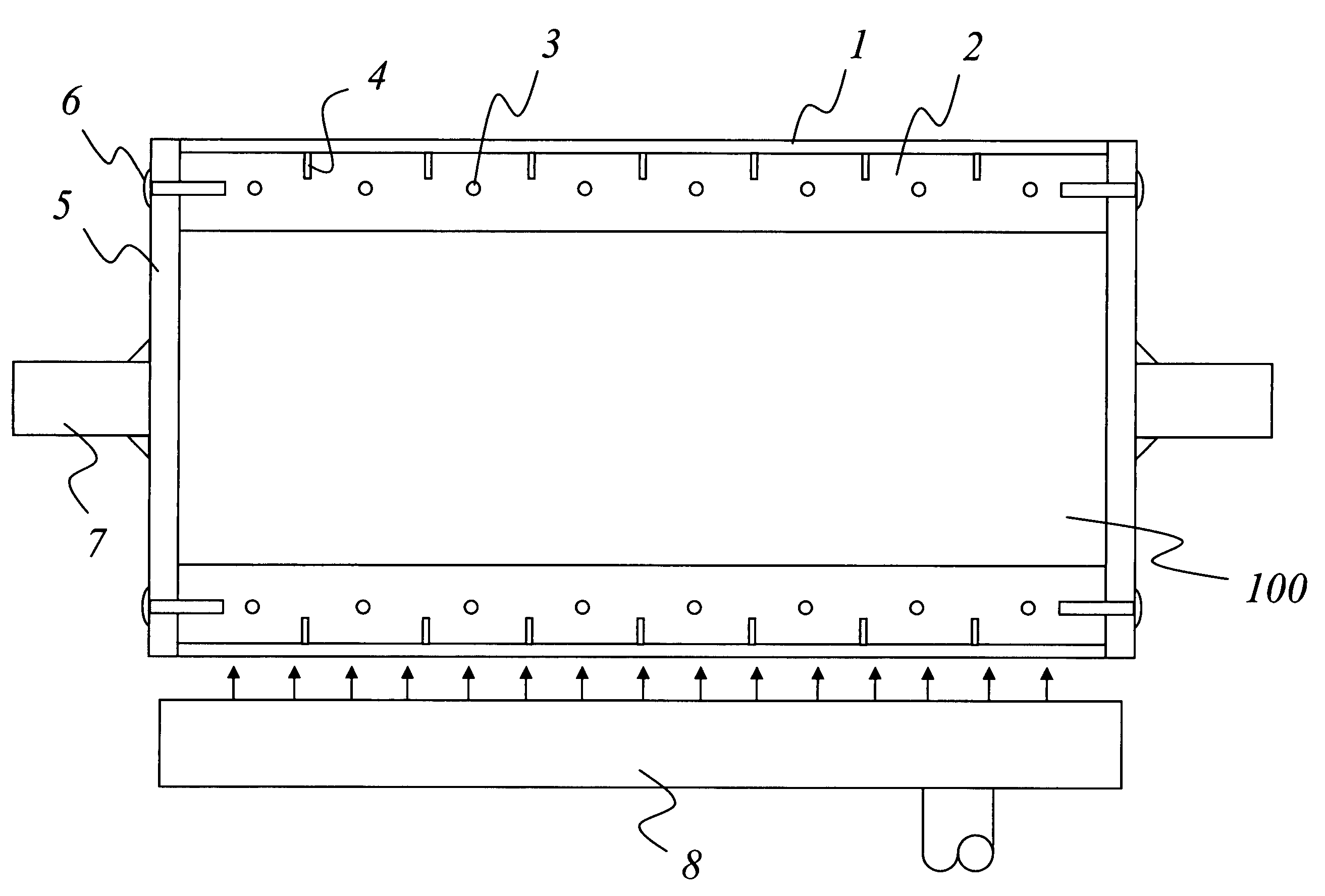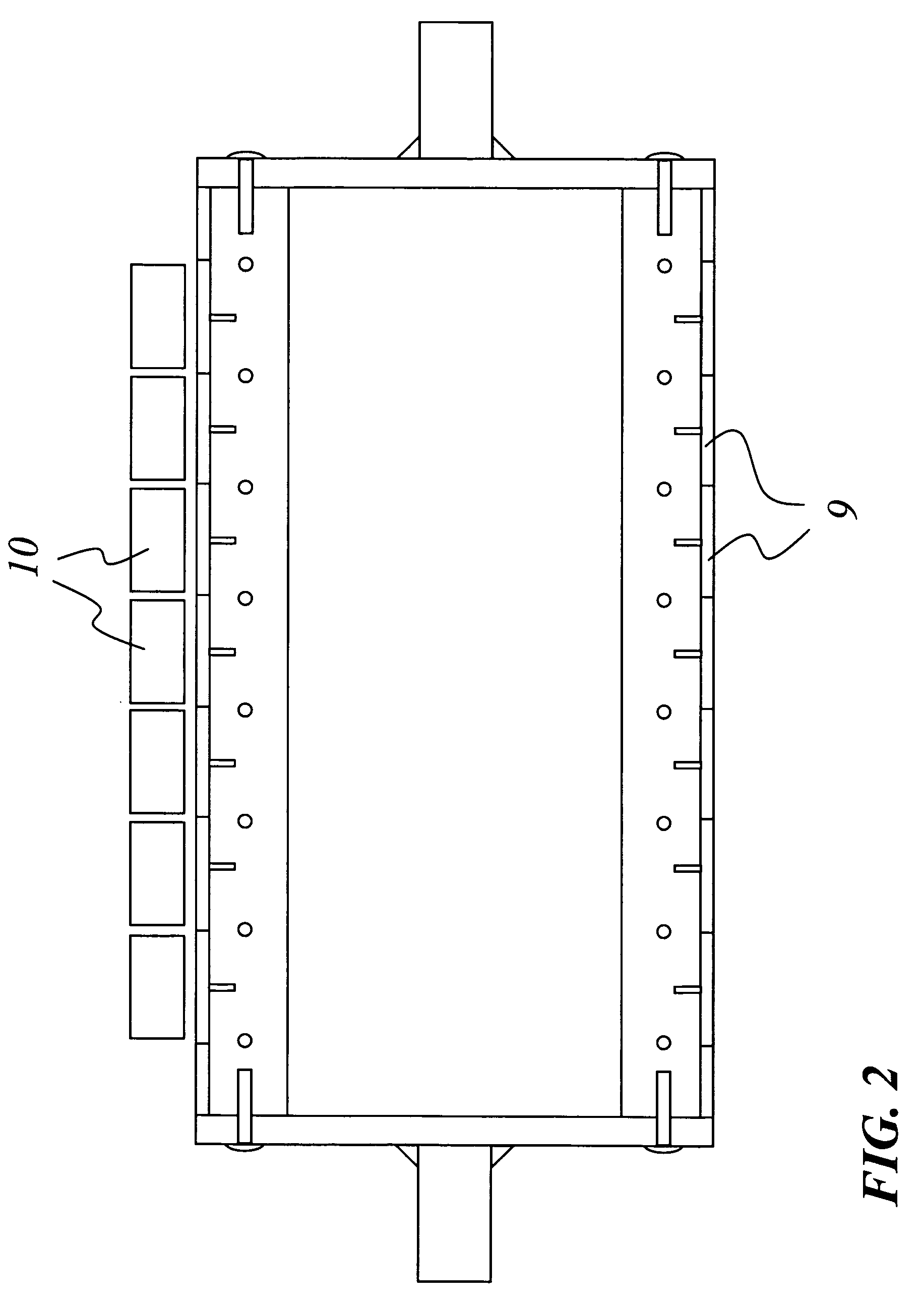Or, conversely, the relatively low
thermal conductivity of ferrous metals may limit the lateral heat conduction to a rate lower than is optimal for a specific application.
The historical use of
internal heating fluids, and the need for high roll stiffness during
calendering has resulted in conventional heated
calendering rolls being relatively thick-walled (typically with wall thickness of more than one inch, or
solid throughout), with elaborate and expensive cross-bored fluid channels and rotating seals.
Furthermore, conventional heated calendering rolls are made of an essentially homogeneous, moderately thermally-conductive material, such as steel, throughout their full wall thickness, to permit unimpeded heat conduction from the inside to the outside.
The external fluid heating systems that accompany conventional heated calendering rolls are also relatively inefficient due to
piping circuit
heat losses and energy conversions losses (their original source of energy is often
natural gas or
heating oil, requiring energy conversion with attendant
combustion and
heat exchanger inefficiencies).
Requisite external
fluid temperature control systems must also be able to cool the fluid (to enable precise roll
temperature control, and to remove the heat quickly during stoppages), which adds to the overall complexity and cost.
A primary limitation of conventional heated calendering rolls is that they are relatively thermally-conductive throughout their substantial depth, requiring that their whole
mass be heated up to attain a desired outer surface temperature.
Furthermore, the large
mass of internal fluid used by conventional heated calendering rolls also has to be heated before it can heat the roll, or cooled before it can cool the roll.
The large roll and fluid mass, and the long radial conductive path throughout the depth of the roll, thus produces a large
thermal inertia that reduces the
response time of roll temperature controls to process disturbances on continuous operations, and which furthermore thus imposes a severe setup and change-over
delay on discontinuous, batch-type calendering processes.
Over-
sizing these fluid-cooling and heating systems beyond what steady-state conditions require adds significantly to their size, complexity and
initial cost, and further aggravates their inherent energy inefficiencies.
A further limitation of conventional heated calendering rolls is that they are homogenous across their width, and the internal fluid paths are continuous across their entire width, making it impossible to locally heat just one cross-direction region of the roll.
If the roll temperature is not sufficiently uniform it may impart a non-uniform temperature profile to the web(s) before or during laminating or
embossing.
This in turn may affect the web's localized
compressibility, malleability, and dimensional stability, leading to variable finished product quality.
While on high
throughput web
manufacturing operations such as
papermaking it is cost effective to measure and control web properties in narrow zones across the width, such investments are usually not viable on converting applications that are typically much narrower and slower.
Consequently, narrow zone control of effective roll heating means such as external magnetic induction, is often not commercially viable on converting applications.
Unfortunately, such rolls are relatively expensive to build, they often require fluid connections, and they typically require a significant internal structural mass, which along with the internal fluid itself, adds to their
thermal inertia to lengthen their heat-up response.
The
response time and cross-direction heat migration limitations mentioned above for web calendering applications apply equally to web converting applications, especially in that preheating cans are homogenous across their width, with a single internal steam chamber, making it difficult to locally heat just one
lateral region of the preheater can to localize the
drying or
heating effect in a given
lateral region of the web.
As with the previously described heated calendering applications, the historical use of internal fluids has resulted in conventional curing / heat-setting rolls being relatively heavy-walled with elaborate and costly internal fluid channels and rotating seals.
These curing / heat-setting rolls are also made of a homogeneous, thermally-conductive material, such as steel, throughout their depth, and are also typically accompanied by an expensive and over-sized external fluid cooling and
heating system to quickly remove and add heat before and after stoppages.
Curing / heat-setting rolls are also homogenous across their width, and the internal fluid paths are continuous across their entire width, making it impossible to locally heat just one cross-direction region of the roll.
Web shrinkage is typically a somewhat non-uniform phenomenon, occurring more freely and uniformly at the edges, and less easily and uniformly near the center of the web due to friction between it and contacting
machine elements, such as rolls.
This cross-direction non-uniformity often produces wrinkles in the web as it shrinks, which in turn may have a deleterious effect on the final quality of the web.
The above examples clearly illustrate that on many web manufacturing and converting applications the design of conventional heated rolls, and their method of heating, imposes significant limitations, and that these limitations will apply equally or in part to other web applications involving heated rolls.
Unfortunately the above-described conventional rolls cannot fully
exploit the benefits of this new
induction heating technology.
Even though state-of-the-art induction technology heats just the surface region of a steel roll, where the
thermal energy is actually needed by the process, that heat must unfortunately migrate into the roll and internal fluid, and heat up the entire combined mass before the surface temperature can be stabilized at a target value.
 Login to View More
Login to View More  Login to View More
Login to View More 


